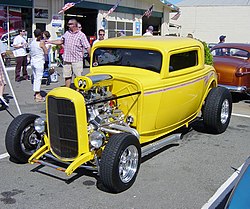


Hot rods are typically American cars that might be old, classic, or modern and that have been rebuilt or modified with larger engines optimized for speed and acceleration. [2] One definition is: "a car that's been stripped down, souped up and made to go much faster." [3] However, there is no definition of the term that is universally accepted and the term is attached to a wide range of vehicles. [4] Most often they are individually designed and constructed using components from many makes of old or new cars, and are most prevalent in the United States and Canada. [4] Many are intended for exhibition rather than for racing or everyday driving. [4]
Contents
- Etymology
- History
- 1920s to 1945
- 1945 to 1960
- 1960 to present
- In modern culture
- Lifestyle
- In popular culture
- In Sweden and Finland
- Gallery
- See also
- References
- External links
The origin of the term "hot rod" is unclear. Some say that the term "hot" refers to the vehicles being stolen. Other origin stories include replacing the engine's camshaft or "rod" with a higher performance version. According to the Hot Rod Industry Alliance (HRIA), the term changes in meaning over the years, but "hot rodding has less to do with the vehicle and more to do with an attitude and lifestyle". [5] For example, hot rods were favorites for greasers.
The term has broadened to apply to other items that are modified for a particular purpose, such as a "hot-rodded amplifier".














